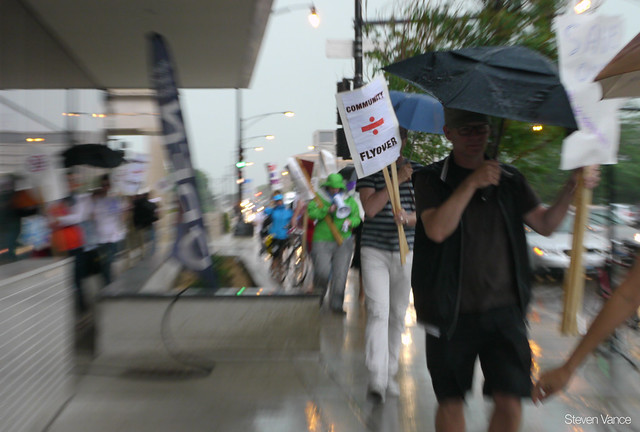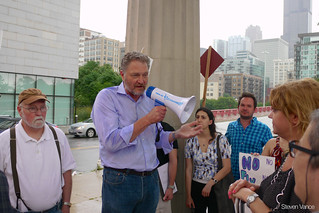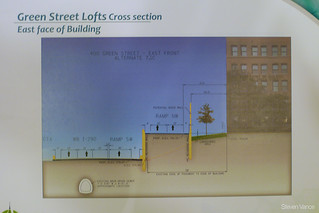The Illinois Department of Transportation showed final plans for the Circle Interchange expansion last Thursday at the last public meeting about the project. You now have a week and a half to tell IDOT your thoughts on the record before the public comment period ends July 12 (see how below).
Since the last public meeting, IDOT has made changes to the option it wants to build, including increasing the distance of a highway ramp from people's homes and adding green space at the corner of Van Buren and Halsted Streets, but the Circle Interchange project remains an expensive and unnecessary highway expansion that hijacked the regional planning process.
The danger of expanding highways
IDOT justifies the Circle Interchange project by saying that adding traffic lanes will improve regional mobility at the nation's most congested interchange for freight traffic. But only 8.25 percent of the traffic here is freight (33,000 out of 400,000 vehicles daily) and adding highway lanes without tolling them will encourage more driving. Truckers will be stuck in the same mess and so will taxpayers. Meanwhile, 1,000 transit trips will switch to car trips, according to an analysis by the Chicago Metropolitan Agency for Planning.
Before the meeting, a group of 15 residents opposed to the project gathered at the southern Greektown gateway to hear Congress for New Urbanism president and former Milwaukee mayor John Norquist describe how Detroit solved its congestion problem ("by building freeway after freeway") but created a people problem -- a city with dwindling population, disconnected neighborhoods, and overburdened public budgets.
Changes to the project
IDOT made changes to the "preferred alternative," Alternative 7.1C, to move the Halsted flyover further away from the residence at 400 S Green Street, where residents fear the noise and foundation-damaging vibrations. The building's face will now be 26 feet away from the highway (instead of 7 feet) and its 23-foot tall noise wall.
I asked resident Arlene Manelli if she would prefer keeping the view over the highway (which is currently sunken) but having the new flyover in view, or the wall that will block views from the first two floors. "From a noise perspective, I want the wall." She added that because of the flyover is wider and can fit more cars than the existing ramp, she expects more people to drive, and drive faster, thus making more noise.
IDOT also presented new designs for the grade change where the Peoria Street bridge meets the roadway in front of the UIC urban planning college. There were nine options proposed, all of which eliminate parking from the bridge and push the CTA headhouse back to create a wider pedestrian area, which was originally presented in the Peoria Street Pedestrian Street proposal. Like that proposal, some of the options create a nearly-single grade roadway for a more pedestrian-focused street. This is one area where all IDOT's talk about "enhancing the community" actually makes some sense.
Speaking of which, many of IDOT's marketing materials -- the newsletter, postcard, and presentation video -- referred to how the Circle Interchange will "enhance the community." Here's what the video narration said: "Well-designed flyovers won't divide communities," and "this creates a gateway to Greektown, connecting communities." How? With wider sidewalks, bike lanes, landscaping, decorative fencing and handrails, and aesthetically-pleasing lightbulbs. The actual flyover -- which will impose a 32-foot wide concrete structure overhead -- has nothing to do with connectivity or community enhancement.
The plan for bike lanes on Halsted between Van Buren and Harrison Street keeps changing. Halsted Street currently provides a northbound bike lane. At one point one of the two northbound travel lanes was removed to make room for buffered bike lanes, but now the plan calls for two curbside bike lanes without buffers. Mike Eichten, a project consultant with AECOM, said that these bike lanes are still under negotiation.
Meanwhile, the only transit improvement in the project remains a covered mid-block pedestrian crossing for CTA riders transferring to and from buses and trains.
Dubious safety claims
IDOT has also stressed "safety" as a reason to rebuild and expand the Circle Interchange. But how many people are actually getting hurt with with current design, and is this project a smart way to reduce injuries and deaths? IDOT's Environmental Assessment report says a "review of the crash data and patterns collectively" indicates "a need for improvement to the existing facility," meaning to widen segments of the interchange. Measuring injuries is the best way to understand danger and risk, yet all of IDOT poster boards focused purely on the number of crashes, not injuries. With "940 crashes" per year shoved in your face, you may think that the Circle Interchange is quite unsafe. But a large majority of crashes involve no injuries.
The most common crash type for the reported period of 2006-2008 in the surveyed location (which included through lanes, Circle Interchange ramps, and the on and off ramps) was "rear end" -- 56.8 percent of all crashes. In that period, 89.9 percent of crashes resulted in no injury, while 1.31 percent of crashes resulted in "incapacitating injuries" or fatalities. All told, there were eight deaths. Of those fatalities, five occurred in a single crash caused by a speeding, 29-year old driver going the wrong way at 2 a.m. near Racine Avenue.
Keep in mind, over that same period, 140 pedestrians died in Chicago car crashes. But we don't see $475 million from IDOT to prevent future pedestrian deaths.
Ultimately, IDOT is only accountable to Governor Quinn's office, and, to a lesser extent, the Federal Highway Administration -- not to people who will have to live, work, and travel around the project.
Comments about the environmental assessment (EA) are being accepted through July 12, 2013. You can leave a comment (to go on public record) at the contact form on the project's website, or email project manager Steve Schilke.







